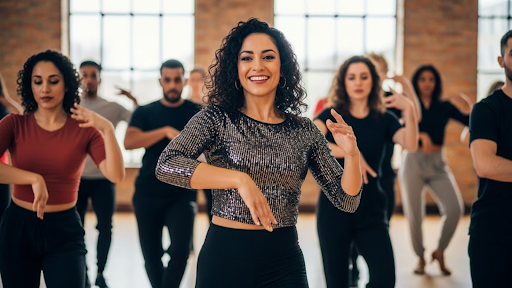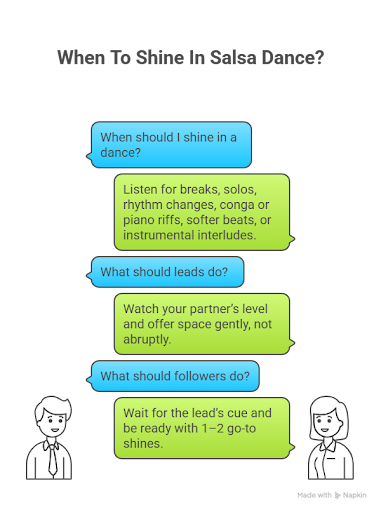A Detailed Guide To Mastering Salsa Shines
Posted on - 22 July 2025

Salsa shines are solo footwork sequences performed during breaks from partner work. These sequences allow dancers to show off their unique style, rhythm, and musicality. Here is your guide explaining everything you need to know about salsa shines from origin to practice tips and more!
As a Salsa dancer, there's one area where many of us feel stuck – “Salsa Shines”. Partner work feels great, but without fluency in shines, things can feel awkward and incomplete. Lacking exposure to the spotlight (Salsa shines) can make dancers feel less confident, whether socially or on stage. Many of us even ask our instructors or fellow dancers questions like:
When should you add shines to your dancing?
How much time should you practice them in class?
Are Salsa shines really worth it?
If you've ever found yourself asking these questions, you're not alone!
Many dancers, especially beginners or those in areas with limited shine-focused classes, struggle with the same questions.
But the truth is, Salsa shines are key to taking your dance to the next level, allowing you to connect better with the music.
Here is a guide that answers all your Salsa shine questions, clears up myths, and gives you easy tips to make shines part of your Salsa journey.
Let's get started.
Key Points:
Salsa shines are solo footwork moves that let dancers show off their style and musicality during breaks from partner work.
Start Slow: Beginners should focus on partner work first, adding simple shines like Suzy Q after getting the basics down.
Class Time: Most classes should spend 10–15 minutes on shines (more time in advanced or performance classes).
Practice Regularly: Practice 10–15 minutes, 2–3 times a week with music and mirrors to improve timing, confidence, and flow.
Worth It:: Shines improve footwork, confidence, and musical connection, making them great for all dancers.
The Origins And Importance Of Salsa Shines
Shines originated in the mambo era of the 1940s and 1950s in Cuba and New York City. During this time, dancers would take breaks to display their timing and agility. Influenced by famous dancers like Fred Astaire, shines became a key part of Salsa.
Today, Salsa shines are used in various Salsa styles, such as New York (On 1 or On 2) and Cuban Salsa. Shines give dancers a moment to express themselves and connect more deeply with the music, and add excitement to social dancing.
Salsa shines matter for the following reasons:
Help you connect with Salsa’s rich rhythms (congas, bongos, piano)
Boost confidence for social or stage dancing.
Breaks the monotony and adds variety and excitement to partner work.
Shine Practice Formula:
Footwork + Isolation + Timing → Better Partnerwork
What Are Some Basic Salsa Shines For Beginners?
Confidence in simple shines looks better than rushed complexity!
At first, dancers start with the simple shines to build confidence and lay the foundation for more complex moves. Here are beginner-friendly shines that most Salsa dance instructors teach in the beginning:
| Shine | Description |
| Suzy Q | Step side to side, crossing one foot over the other on each beat (1-2-3, 5-6-7). |
| Side Break | Step side to side with a tap or pause on the beat, emphasizing rhythm. |
| Cumbia Step | Forward and back step with a slight hip movement, grounded and smooth. |
| Step Touch (Piano Step) | Add taps between basic steps to highlight musical accents. |
How to Practice:
Choose a slow Salsa track (e.g., “Ran Kan Kan” by Tito Puente).
Practice in front of a mirror to check form and posture.
Count the beats (1-2-3, 5-6-7) to stay on time.
Repeat each shine for 2–3 minutes, gradually increasing speed.
Pro Tip: Focus on making the footwork clean before adding arm styling or hip movements.
What Are Some Advanced Salsa Shines?
Once you’ve mastered the basics, you will be ready to learn advanced shines for more flair, balance, and timing. Here are the shines for dancers who are ready to upgrade their moves:
| Shine | Description |
| Crossover Step | Cross one foot over the other while turning, adding spins or syncopation. |
| Grapevine with Isolations | Side-travelling step with shoulder rolls or chest pops to highlight music. |
| Locked Right Turn | A full turn on one foot with the other locked behind, requiring balance. |
| Suzy Q with Paddle Turn | Combine Suzy Q with a paddle turn for dynamic movement. |
How to Practice:
Use a mid-tempo track (e.g., “La Vida Es Un Carnaval” by Celia Cruz).
Break down complex shines into smaller segments.
Experiment with body isolations (e.g., hips, shoulders) to add personality.
Pro Tip: Film your shines video and match your moves with a YouTube video of your dance instructor to see improvement and places that need more work.
When Should You Start Learning Salsa Shines?
What is the right time to add Salsa Shines to Your Routine? It depends on your skill level, goals, and comfort with Salsa’s fundamentals. Here’s a detailed guide:
Beginners (0–6 months):
Start with basic steps like forward-back and side-to-side, while keeping your main focus on partner work.
After 2–3 months, when you feel confident with timing and simple moves, start practicing easy shines like Suzy Q or Side Break.
Practice shines for 10–15 minutes each session to build rhythm without stress.
👉A key milestone is feeling comfortable with the Salsa rhythm and basic partner connection.
Intermediate Dancers (6 months–2 years):
Once you're good at partner work, start adding shines to your practice. Do them 2–3 times a week for 15–20 minutes.
Focus on matching the shines to the music, like during breaks or solos.
Try shines in social dancing when the music changes or your partner gives a break.
👉 A key milestone is when you're ready if you can lead or follow well and stay on beat, even when it gets tricky.
Advanced Dancers (2+ years):
Shines should flow naturally in your dancing. Use them to ✅ hit musical accents, ✅ fix timing mistakes, or ✅ show your style.
Practice harder, shines as Crossover Step or Syncopated Flairs, adding more body movements to the routine.
Switch smoothly between partner work and shines, depending on the music and your partner’s vibe.

How Can You Improve Your Salsa Shines? Top Tips
Salsa shines take time to look fluent; focus on progress over perfection!
Here are expert tips to elevate your shines:
Listen Deeply:Focus on specific instruments (e.g., congas, piano) to guide your footwork and enhance the musicality.
Start Slow:First practice shines at slower tempos (160–180 bpm) before moving to faster tracks (200–220 bpm).
Use a Mirror:Keep your posture, foot placement, and body isolations in check for clean execution.
Add Personal Flair: Add arm styling, hip movements, or shoulder rolls to add a personal touch to your Salsa shine.
Practice Regularly:Give 10–15 minutes, 2–3 times a week, to build muscle memory of Salsa shines movements.
Salsa Shine Unsaid Rules:
For Leads: Monitor your partner during shines. If they stick to basics or seem hesitant, transition back to partner work quickly to maintain connection.
For Followers:Wait for the lead’s cue to shine, but at the same time have go-to shines ready to engage playfully.
Should Shines Be A Quarter Or Half Part Of Salsa Classes?
How much time should Salsa classes dedicate to shines? The debate over class time allocation for shines versus partner work is a lively one in the Salsa community.
Some instructors advocate for equal time (50%) to develop both skills, while others suggest a quarter (10–15 minutes) is sufficient. Here is a better explanation based on your learning level:
Beginner Classes:
Too much shine early = confusion!
Focus mostly on the partner work and only 10-15 minutes of basic shines.
Intermediate Classes:
Split time: ~30 mins partner work, ~30 mins shines to build confidence + musical style.
Advanced Classes / Shine Workshops:
Up to 45 minutes of shines will help you work on complex steps, body moves, and musicality
Moreover, if you want to learn how to do salsa and bachata shines in heels, check this blog!
Common Mistakes When Learning Salsa Shines
“What are common mistakes in Salsa shines?” is a question every beginner usually has. Here’s a table showing common Salsa shines mistakes with their corrections:
| ❌ Wrong | ✅ Right |
| 🕒 Getting off-beat | 🎵 Practice with a metronome or slow music (e.g., 160 bpm); count aloud |
| Stiff movements | 💃 Do body isolation drills (e.g., hip circles, shoulder rolls) |
| 🤯 Overcomplicating | 🧘 Start with simple shines; build confidence before layering complexity |
| 🙉 Ignoring the music | 🎶 Match shines to musical accents (e.g., breaks, hits); repeat one song |
| 😰 Fear of mistakes | 😎 Dance with confidence; mistakes are part of the learning process |
Quick Salsa Shine Mistake Fix:
If you lose timing during a social dance, revert to a basic step or tap to recover discreetly.
Are Salsa Shines Worth The Effort?
Shines help you improve your steps, feel more confident, and connect better with the music. They make your dancing look more exciting. Shines are great for performers who want to stand out, and for social dancers who want to add style.
Yes, shines can be tricky at first (like staying on beat, moving your body smoothly, or feeling nervous), but with regular practice, you can get better!
If you want to learn Salsa, cumbia, or bachata dance in Orange County or practice shine or heel routines, RF Dance is your destination. We are a beautiful community of instructors and learners who make dancing fun for each other every day.
For those not in Santa Ana, Orange County, explore our YouTube and TikTok channels for tutorials and to expand your repertoire. Happy learning!
FAQ:
Q1: Are shines only for performances?
A1:Shines are a key part of social dancing. They add variety, musicality, and personal flair—even on the social floor.
Q2: Aren’t shines too difficult for beginners?
A2:Basic shines like the Suzy Q are beginner-friendly. Start simple, and with practice, you’ll build up smoothly.
Q3: Do shines take away from partner work?
A3:Shines enhance partner work by refining your timing, footwork, and overall confidence.
Q4: Can I practice shines without a partner?
A4:Shines are solo exercises—just play music, stand in front of a mirror, and practice anywhere.
Q5: Aren’t shines just for followers?
A5:Both leads and followers can and should shine. Leads often use shines for style or recovering timing, while followers shine to express themselves.
 RF Dance
RF Dance